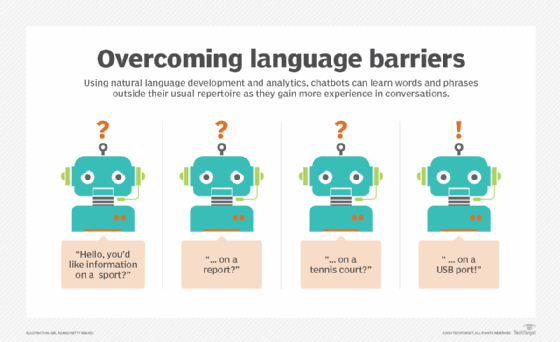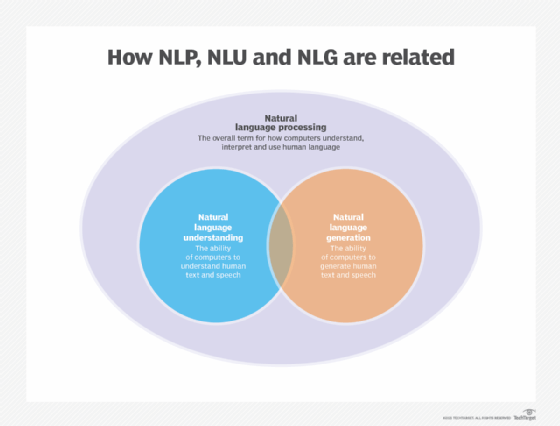
What is conversational AI (conversational artificial intelligence)?
Conversational AI, also known as conversational artificial intelligence, is a type of AI that enables computers to understand, process and generate human language. Conversational AI models are trained using large amounts of data and work using a combination of machine learning (ML), natural language processing (NLP) and other processes.
Conversational AI has primarily taken the form of advanced chatbots. They're different from conventional chatbots, which are predicated on simple software programmed for limited capabilities. Conversational chatbots combine different forms of AI for more advanced capabilities. The technologies used in AI chatbots can also enhance conventional voice assistants and virtual agents. The technologies behind conversational AI platforms are rapidly improving and expanding.
A conversational AI chatbot can answer frequently asked questions (FAQs), troubleshoot issues and even make small talk -- contrary to the more limited capabilities of a static chatbot with narrow functionality. Static chatbots are typically featured on a company website and are limited to textual interactions. In contrast, conversational AI interactions are meant to be accessed and conducted via various mediums, including audio, video and text.
Aside from chatbots, conversational AI is used in different areas where understanding human language is key, such as sentiment analysis, text-to-speech and speech-to-text.
This article is part of
What is enterprise AI? A complete guide for businesses
How does conversational AI work?
Conversational AI combines NLP and ML processes with conventional, static forms of interactive technology, such as chatbots. This combination is used to respond to users through interactions that mimic those with typical human agents. Static chatbots are rules-based, and their conversation flows are based on sets of predefined answers meant to guide users through specific information. A conversational AI model, on the other hand, uses NLP to analyze and interpret the user's human speech for meaning and ML to learn new information for future interactions.
NLP processes large amounts of unstructured human language data and creates a structured data format through computational linguistics and ML so machines can understand the information to make decisions and produce responses. An ML algorithm must fully grasp a sentence and the function of each word in it. Methods like part-of-speech tagging are used to ensure the input text is understood and processed correctly.
Regardless of the scope and purpose of a conversational AI tool, the process by which end users interact with it and vice versa typically includes the following four steps:
- Input generation and reception. End users create input, such as a query, and the tool receives it. It can be a textual input or a voice prompt -- which requires voice recognition technology to convert it into machine-readable text.
- Input synthesis and analysis. To understand the meaning of user input, the tool relies on natural language understanding (NLU) to successfully process and analyze it.
- Output generation. Using its key components -- particularly the dialogue design, training data and ML algorithms its developers used to prepare it -- the tool generates output. This output can range from simple answers to complex responses depending on what the user's input requires.
- Output delivery. The requested output is delivered back to the user.
What are some examples and use cases of conversational AI?
Organizations can build and apply different types of conversational AI tools for various practical uses. Examples include the following:
- All-encompassing, subscription-based chatbots. These advanced chatbots generate text to answer user queries on a range of topics. Foremost among these tools is OpenAI's ChatGPT. OpenAI requires users to present login information to interact with the application.
- AI-powered search engine assistants. A search tool with AI functionality can quickly produce search results that best match a user's query. The most prominent examples are Google Gemini and Microsoft Copilot in Bing.
- Conversational business intelligence (BI) apps. Conversational BI combines conversational AI with data analytics capabilities -- in a sense, letting users talk to these applications and receive outputs in the form of data visualizations and explanations. A conversational BI application is integrated with a database or data warehouse from which it retrieves data needed for analysis and visualization.
- Customer service chatbots. The most well-known chatbots and virtual assistants are on company websites, offering limited responses to customer inquiries and some predetermined functionality. Virtual assistant platform vendors offer services to help businesses better engage with their customers.
- Sentiment analysis. Conversational AI is used in sentiment analysis tools to help gauge the emotional tone behind text. This enables organizations to analyze customer reviews or comments to collect data regarding whether they're happy, neutral or frustrated.
- Text-to-speech and speech-to-text. Conversational AI is also used in text-to-speech and speech-to-text tools to enable voice-based interactions.

Why conversational AI has become increasingly prevalent
Conversational AI has become more and more widespread in the last few years, as companies find ways to take advantage of its benefits.
Advances in NLP, NLU and ML processes enable AI systems to understand and generate human-like and context-aware responses. These advancements in AI are changing the ways we interact with computers in different settings.
Conversational AI offers instant and continual support, which is useful for providing more dynamic and responsive customer service options. It also provides increased automation, making it a cost-effective and scalable option.
Conversational AI is integrated into AI assistants like Siri, Amazon Alexa and Google Assistant so they can better understand and respond to user prompts. Apple began integrating its own Apple Intelligence in its phones starting with the iPhone 16, which is designed to improve language understanding in Siri.
In many ways, conversational AI used in chatbots, speech-to-text and other systems offers more personalized and efficient experiences. As these systems continue to improve, conversational AI is likely to become even more prevalent in everyday life.
Processes and components of conversational AI models
NLP technology is required to analyze human speech or text, and ML algorithms are needed to synthesize and learn new information. Data and dialogue design are two other components required within conversational AI. Developers use both training data and fine-tuning techniques to tailor a system to suit an organization's needs.
Additionally, the following two subareas of NLP play a crucial role in conversational AI:
- NLU enables a machine or application to process the language data in terms of context, intent, syntax and semantics, as well as ultimately determine the user's intended meaning.
- Natural language generation (NLG) is the process by which the machine generates text in human-readable languages, also called natural languages, based on all the input it's given. The goal of an NLG system is to explain the AI's structured data to humans.

What are the benefits and challenges of conversational AI?
Conversational AI is expanding and offering benefits to many different types of businesses. Organizations across different industries, including the following, can apply conversational AI to a range of scenarios and reap the benefits:
- Healthcare. Conversational AI can help patients describe their conditions online through a series of questions meant to circumvent wait times.
- Retail. When customer service representatives aren't available, AI-powered chatbots can meet customers' demands on a 24/7 basis, even during holidays. Historically, call centers and in-person visits were the only way to interact with customers. Now, customer support is no longer limited to office hours because AI chatbots are available through various mediums and channels, including email and websites.
- Banking. Poorly implemented conventional chatbots can frustrate customers. Instead, banks can use AI chatbots to handle complex requests. When dealing with customers' finances, it's especially important to eliminate common human errors and deliver precise and accurate responses to address concerns.
- Internet of things. Common household devices have conversational AI capabilities via interfaces such as Amazon Alexa and Apple Siri. Conversational AI agents are also integrated into smart home devices.
- Human resources. Conversational AI can automate the time-consuming human resources process of sifting through candidate credentials manually during the job recruitment process.
- Accessibility features. Conversational AI can enable better user accessibility by providing voice-activated assistance for those with disabilities. For example, individuals with visual impairment or mobility challenges can use voice-enabled controls to a greater degree of accuracy using natural speech.
Developers and their organizations must also consider some common challenges with conversational AI systems, such as the following:
- Language translation. Many conversational AI models have thus far been trained primarily in English and can't interact with non-English speakers in their native languages. Multilingual proprietary chatbots are an option for customer service at companies with global operations.
- Security. Companies that conduct customer interactions via AI chatbots must have security measures in place to process and store the transmitted data.
- Difficulty interpreting certain words and contexts. Conversational AI can be thrown off by slang, jargon and regional dialects, which are all examples of the changing nature of human languages. Developers are starting to train the technology to address such challenges.
- Biased outputs. A conversational AI can produce biased responses if it was trained on a limited amount of data. If the training data isn't diverse enough, a conversational AI system might not understand certain accents or could relay inaccurate information, for example.
Conversational AI vs. generative AI
Conversational and generative AI are two distinct concepts that are used for different purposes. However, there's some overlap. For example, ChatGPT is a generative AI tool that can generate journalistic articles, images, songs and poems. It's also a highly advanced chatbot that organizations can use for customer service.
Conversational AI
Conversational AI is focused on NLP- and ML-driven conversations with end users. It's frequently used to get information or answers to questions from an organization without waiting for a contact center service rep. These types of requests often require an open-ended conversation. Hence, users need a conversational AI tool.
Training data provided to conversational AI models differs from that used with generative AI ones. Conversational AI's training data could include human dialogue so the model better understands the flow of typical human conversation. This ensures it recognizes the various types of inputs it's given, whether they are text-based or verbally spoken.
Generative AI
Generative AI is focused on the generation of content, including text, images, videos and audio. If a marketing team wants to generate a compelling image for an advertisement, the team could turn to a generative AI tool for a one-way interaction resulting in a generated image.
The training process for generative AI models uses neural networks to identify patterns within their training data. This analysis, along with human guidance, helps generative models learn to improve the quality of the content they generate. Ultimately, their goal is to produce outputs that are accurate and realistic.
How to create conversational AI
Before developers can start working on building a conversational AI application, a planning and creation process is required. This process should assess the scope and conversation structure that a tool is expected to follow when users interact with it. The steps involved include the following:
- Compile potential inputs from end users. Assembling a list of inputs expected from end users during interactions is the first step in this process. An existing FAQ list or data collected from previous customer interactions is enough to move forward.
- Craft scope and purpose with sample inputs. From the potential user inputs gathered in the first step, it's possible to glean what users are probably looking for in their interactions with the conversational AI tool. It's important to consider the manner or phrasing they might use when making requests. Using all this information to define the scope and purpose of the tool makes it comprehensive enough to handle various user inputs and respond to the different ways requests are made.
- Define goals. With enough data and sample inputs, specific requirements and goals can be identified for the tool. These lay the groundwork for the design of full dialogue or conversation flows with future intended users.
- Design and test a prototype. Once all requirements are identified, a prototype model is designed and built. This approach lets developers determine if what they're thinking works and to identify possible issues.
- Test the model with end users. Human developers guide and train the prototype tool through the potential interactions and scenarios it will have with users. The result should be a conversational AI tool that can interact smoothly with humans and answer questions with appropriate responses.
- Reinforcement learning. Reinforcement learning, as part of the training process, conditions a model to produce more accurate outputs over time. This method rewards the model for producing desired outputs and steers it away from erroneous ones. This optimizes model performance.
Conversational AI Platforms and what to look for in them
According to the Forbes article "What Is Conversational AI? Examples And Platforms," a sampling of conversational AI platforms include the following:
- Amazon Lex. Developers can use the same deep learning technologies that power Amazon Alexa to create natural language-driven chatbots with Amazon Lex.
- IBM watsonx.ai. This cloud-based platform uses generative AI. It's a conversational AI tool that's designed for handling tasks like sentiment analysis and customer service interactions.
- Kore.ai. This enterprise-focused chatbot uses conversational AI. It's designed for automation and streamlining business workflows for large organizations with specific needs.
- Microsoft Bot Framework. Developers can create customized chatbots for channels including Skype, Teams and Facebook Messenger and integrations with Microsoft products.
- Rasa. Rasa is an open-source platform that enables developers to create and customize chatbots to an organization's specific needs.
While assessing conversational AI platforms, an organization must first consider what type of platform and tool best aligns with their needs. Some of these considerations include the following:
- Ease of implementation.
- Integrations.
- Pricing.
- Scalability.
- Security.
- Support from the vendor.
Conversational AI tools can deliver good customer service experiences, but they also come with some problems. Learn more about the inherent risks associated with using ChatGPT and other AI tools for these tasks, including false information, biases and security concerns.






